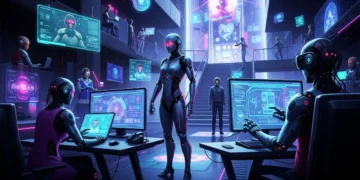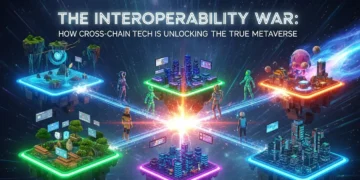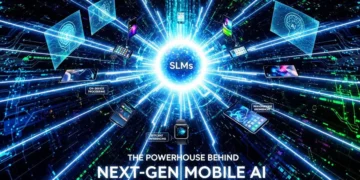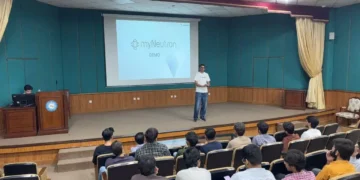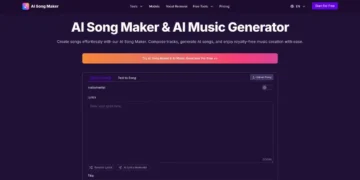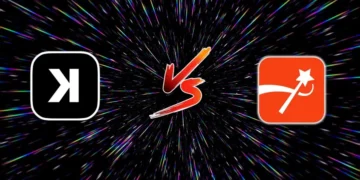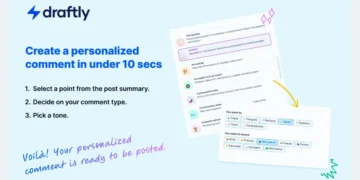Imagine buying a legendary sword in a fantasy game on one blockchain, only to find it’s trapped there, useless everywhere else. Now, imagine that same sword—a verifiable, unique digital representation of ownership on the blockchain—being your key to a racing game on a different network, collateral for a loan on a third, and your avatar’s prized possession in a virtual social hub. This seamless flow is the dream of the open metaverse, and it’s a dream currently lost in translation.
The problem? We’ve built magnificent, walled digital cities—Ethereum, Solana, Avalanche, Polygon—that can’t speak to each other. This lack of communication, known as the blockchain interoperability problem, is the single greatest barrier to a truly connected and user-owned internet, or web3. But a silent war is being waged to tear down these walls, and the weapons of choice are cross-chain bridges, oracles, and revolutionary cross-chain smart contracts.
This isn’t just a technical debate; it’s a battle for the soul of the next internet. Are we building a series of isolated islands, or a unified continent of digital experiences? The answer lies in the technology we’re about to explore. So, are you ready to see how the digital walls are finally coming down?
What is Blockchain Interoperability? The Foundation of a Unified Web3
At its core, interoperability in blockchain is the ability for different, independent blockchain networks to see, share, and use information and assets between each other without needing a central intermediary. Think of it like the internet: you can send an email from a Gmail account to an Outlook account seamlessly. The protocols allow them to interoperate.
In the context of the metaverse and web3, interoperability means your digital identity, assets, and data can move with you. It’s what transforms a collection of separate apps into a cohesive digital universe.
Ask yourself: Would the internet be valuable if you needed a different computer and login for every website? That’s the state of most blockchains today.
Why is Interoperability the Holy Grail for the Metaverse?
The promise of the metaverse is a persistent, immersive, and interconnected digital world. Interoperability is the glue that holds this promise together. Without it, we’re just building better, more immersive versions of the walled gardens we have today.
Consider this: a digital artist creates a clothing line for avatars. Without interoperability, they must recreate and sell that line on every single metaverse platform (Decentraland, The Sandbox, Somnium Space), fracturing their audience and diluting the rarity of their work. With true cross-chain interoperability, they mint one collection, and it’s wearable across all compatible virtual worlds. This isn’t just convenient; it’s transformative for digital economies.
The Fragmented Metaverse: Understanding the Core Problem
Right now, if you buy a digital asset—like a unique skin for your avatar in one game—it’s stuck there. You can’t take it with you to another platform. It’s like buying a coffee mug at one café but being forbidden from using it at any other coffee shop. This lack of interoperability is the single biggest hurdle preventing the metaverse from reaching its full potential. For users, it’s frustrating. For creators and developers, it limits market reach and creates redundant work.
This is precisely the kind of problem that search engines and AI assistants are trying to solve with concepts like Answer Engine Optimization (AEO). Users are asking: “Why can’t I use my assets everywhere?” They want clear, direct answers. Content that provides these solutions by explaining the “how” and “why” of interoperability is primed to rank at the very top. To win in this new landscape, you have to do more than just use keywords; you have to answer the user’s core question.
The Foundation of Digital Identity: What is a Digital Representation of Ownership on the Blockchain?
Before we can talk about moving assets between worlds, we need to understand how we can truly own them in the first place. This is where the blockchain comes in. A digital representation of ownership on the blockchain is most commonly a Non-Fungible Token, or NFT.
An NFT is more than just a JPEG. It’s a unique, non-replicable digital certificate of ownership recorded on a blockchain. This immutable ledger provides transparent, verifiable proof of who owns what at any given time. This is revolutionary because, for the first time, your ownership of a digital item isn’t dependent on a company’s private server; it’s recorded on a decentralized, public network.
This creates the foundation for a user-owned metaverse. Imagine your unique avatar, your plot of virtual land, or your rare in-game item being yours and yours alone, verifiable on a blockchain. Now, the ultimate question becomes: What if your favorite game skin could be worn in any virtual world you visited? To achieve that, we need the contracts that govern these assets to be able to communicate.
The Building Blocks of Cross-Chain Communication
Achieving this seamless connection isn’t simple. It requires a sophisticated stack of technologies working in concert. Let’s break down the key components.
The Engine: What is a Smart Contract Used in a Blockchain Network?
To understand cross-chain tech, you must first grasp the foundation. A smart contract is used in a blockchain network as a self-executing agreement with the terms of the deal directly written into code. It’s the automated, trustless “if this, then that” logic that powers everything from NFT mints to DeFi lending.
But a standard smart contract typically only operates within its native chain web3. It can’t natively access data or trigger actions on a separate blockchain. This isolation is the fundamental problem that cross-chain technology aims to solve.
The Messengers: What Are Oracles and Why Are They Crucial for Blockchains?
This is where oracles come in. If blockchains are powerful computers that are blind and deaf to the outside world, oracles are their eyes and ears. Oracles are crucial for blockchains because they are services that fetch, verify, and deliver real-world (or cross-chain) data to smart contracts.
For example, a smart contract for a crop insurance policy needs to know if it rained. An oracle fetches that weather data and feeds it to the contract. In the context of cross-chain operations, an oracle chain like Chain Link can be used to relay information between blockchains.
Imagine an oracle chain confirming that 100 ETH has been locked in a vault on Ethereum, so that the equivalent amount of wrapped ETH can be minted on Solana. This data relay is the bedrock of secure communication. Projects like Chainlink, with its Chainlink Cross-Chain Interoperability Protocol (CCIP), are pioneering this approach, making the Chain link bridge a term you’ll hear more often.
The Bridges: Unpacking the Cross-Chain Bridge Crypto Phenomenon
The most visible tool in the interoperability toolkit is the cross-chain bridge crypto platform. A cross-chain bridge is a protocol that connects two blockchains, enabling the transfer of assets and data between them.
Think of it as a physical bridge between two islands. You can’t take your car (the native asset) from one island to the other, so you drive it onto the bridge, park it in a secure garage (a locked vault or escrow), and receive a ticket (a wrapped or minted asset) that you can redeem for a car on the other side.
How a typical cross-chain bridge works:
A user sends Asset A from Chain A to the bridge’s smart contract.
The bridge locks or burns Asset A.
The bridge’s validator network (often using oracles) confirms the transaction.
The bridge mints an equivalent “wrapped” Asset A on Chain B and sends it to the user’s wallet.
When the user wants to move back, they burn the wrapped asset on Chain B, and the bridge releases the original Asset A on Chain A.
Did you know? The security of the entire system hinges on the “garage” (the vault) and the validators. If they are compromised, the “tickets” (wrapped assets) become worthless.
The Next Frontier: Cross-Chain Smart Contracts and the Future
While moving assets is a huge first step, the endgame is enabling logic to flow between chains. This is the realm of cross-chain smart contracts.
What Are Cross-Chain Smart Contracts?
These are sophisticated programs whose logic and execution can span multiple, independent blockchains. Instead of a single contract doing everything on one chain, a cross-chain smart contract can delegate specific tasks to the most suitable blockchain.
A Practical Example: A Cross-Chain Decentralized Exchange (DEX)
You’re on Avalanche and want to swap AVAX for SOL on Solana.
You initiate the swap on a cross-chain DEX.
A cross-chain smart contract locks your AVAX on Avalanche.
An oracle chain relays the proof of this lock to the Solana side of the contract.
The contract on Solana executes the trade and releases the SOL to your wallet.
This happens without you needing to manually use a bridge or manage multiple transactions. The cross-chain smart contract orchestrates the entire complex process behind the scenes. This is the kind of seamless experience that will define the user-friendly web3 of the future.
The Challenges and Risks: The Dark Side of Interoperability
The interoperability war isn’t just about building the best tech; it’s about building the most secure and reliable tech. Forcing open connections between sovereign networks creates new attack vectors.
The Bridge Hacking Epidemic
Cross-chain bridges have become the single biggest security vulnerability in web3. Billions of dollars have been stolen in bridge hacks. Why? Because they often become central points of failure, holding vast amounts of locked assets (the “garage”) that are a honeypot for attackers. The security of the entire bridged asset ecosystem depends on the security of the bridge’s validator set, which can be compromised.
The Oracle Problem
We stated that oracles are crucial for blockchains, but they also introduce a trust assumption. If the data provided by an oracle chain is faulty or manipulated, any smart contract relying on it will execute incorrectly, leading to massive losses. The entire system’s integrity is only as strong as its weakest oracle.
The Scalability and Consensus Conundrum
Different blockchains have different security models and consensus mechanisms. How can a fast-but-less-decentralized chain web3 securely interact with a slow-but-highly-secure one like Ethereum? Reconciling these differences without sacrificing security is a monumental challenge. This touches on fundamental rules like the 51% rule in blockchain, where if a single entity controls most of the network’s mining or staking power, they can manipulate it. In a cross-chain context, a 51% attack on a smaller chain could be used to drain funds from a bridge.
The Engine of Interoperability: Key Cross-Chain Technologies
So, how do we break down these walls? The answer lies in a suite of advanced cross-chain technologies that act as translators and bridges between disparate blockchain networks.
Table: Key Technologies Powering Metaverse Interoperability
| Technology | Primary Function | Real-World Example |
|---|---|---|
| Cross-Chain Bridges | Facilitate the transfer of assets and data between two different blockchains. | Wormhole, Polygon Bridge . |
| Interoperability Protocols | Provide a framework for multiple blockchains to communicate, often through a central relay. | Polkadot’s Relay Chain, Cosmos (IBC) . |
| Atomic Swaps | Enable peer-to-peer trading of assets across different blockchains without a centralized intermediary . | Decentralized exchanges (DEXs). |
| Blockchain Oracles | Fetch and verify real-world or cross-chain data to trigger smart contract executions on another chain. | Chainlink . |
| Decentralized Identity (DID) | Allows users to create a single, self-owned identity that works across multiple platforms . | Microsoft’s ION network (built on Bitcoin). |
The Role of Blockchain and Web 3.0
Web 3.0, the next evolution of the internet, is built on principles of decentralization and user ownership. Blockchain technology is its backbone, providing the trustless, transparent, and secure foundation required for interoperability in the Metaverse . By leveraging blockchain, the Metaverse can transition from a corporate-owned model to a user-centric one, where you truly own your digital assets and identity.
Projects like Polkadot ($DOT) and Cosmos ($ATOM) are at the forefront of this war, each with distinct architectural philosophies. Polkadot uses a central Relay Chain with connected parachains to share security and enable interoperability, while Cosmos employs a hub-and-spoke model that gives independent chains more autonomy . Both are critical contenders in shaping the interconnected future of Web3.
Why the Interoperability War Matters: Unlocking a Trillion-Dollar Potential
Winning the interoperability war isn’t just a technical achievement; it’s the key to unlocking immense economic and social value. The integration of cross-chain technology is poised to revolutionize entire industries.
1. For Users: True Digital Ownership and Freedom
Interoperability empowers users like never before. It enables true digital ownership, meaning the assets you buy or earn have utility and value beyond a single platform. This fosters a more vibrant digital economy where users can monetize their time and creativity more effectively, similar to the play-to-earn models seen in games like Axie Infinity and Evolution Land . Imagine being a digital fashion designer whose creations can be worn across dozens of virtual worlds—your customer base and economic opportunity would be global.
2. For Businesses: New Markets and Efficiencies
Enterprises are poised to benefit massively. A 2025 study on Metaverse logistics indicated that supply chain efficiency can improve by 20-30% when integrated with Metaverse and blockchain systems . This is achieved through enhanced transparency, end-to-end traceability, and the automation provided by smart contracts.
Furthermore, cross-chain token launch platforms like Calyx allow projects to “launch once and reach every chain,” tapping into liquidity and users from multiple ecosystems simultaneously . This is a game-changer for fundraising and user acquisition in the Web3 space.
3. For the Metaverse: From Silos to a Unified Reality
Ultimately, cross-chain interoperability is the glue that will bind disparate virtual worlds into a true Metaverse. It allows for a rich, interconnected digital society where social interactions, commerce, and creativity are not bounded by the platform you log into. It enables the vision of a decentralized Metaverse where no single entity has control, and users have the freedom to shape their own experiences .
The Path Forward: A Multi-Chain, Not Maximalist, Future
The goal of this interoperability war is not for one blockchain to “win,” but for all of them to learn to collaborate. The future of web3 and the metaverse is multi-chain.
We are moving towards a world where specialized blockchains (gaming chains, social media chains, finance chains) will interoperate to provide the best possible user experience. Your identity and reputation will live on one chain, your high-performance gaming assets on another, and your financial portfolio on a third, and they will all work together seamlessly through the power of cross-chain protocols.
This vision relies on continued innovation in:
Standardization: Common communication standards, like the IBC protocol used in the Cosmos ecosystem.
Security-First Bridge Design: Moving away from centralized validator sets to more trust-minimized models.
Advanced Oracle Networks: Leveraging decentralized oracle chain networks like Chainlink to provide robust and tamper-proof data.
The Engines of Automation: What is a Smart Contract Used in a Blockchain Network?
If NFTs are the property deeds of the digital world, smart contracts are the automated legal system that manages them. So, what is a smart contract used in a blockchain network? A smart contract is a computer program stored on a blockchain that automatically executes when predetermined conditions are met.
Think of it as a digital vending machine. You insert a specific amount of cryptocurrency (the condition), and the machine automatically dispenses your chosen item (the outcome). There’s no need for a cashier or intermediary. These contracts handle everything from simple asset transfers to complex financial agreements, all with unparalleled transparency and security.
However, a standard smart contract has a critical limitation: it’s confined to its native blockchain. A smart contract on Ethereum can’t directly interact with a smart contract on another network like Solana or Avalanche. This is the digital equivalent of trying to use a European plug in an American socket. To solve this, we need a new kind of contract.
Introducing Cross-Chain Smart Contracts
Cross-chain smart contracts are the next evolution. These are advanced agreements designed to operate across multiple, interconnected blockchains. They enable seamless communication and asset transfers between different blockchain ecosystems, effectively breaking down the walls between them. By using mechanisms like Hash Time-Locked Contracts (HTLCs), these contracts can facilitate transactions across different chains without a centralized intermediary, ensuring that an action on one chain can securely trigger a corresponding action on another.
Building the Bridges: The Technology Connecting Worlds
Having assets and contracts that can theoretically communicate is one thing. Building the infrastructure to make it happen is another. This is where bridges and oracles come into play, forming the critical connective tissue of the interoperable metaverse.
What is a Cross-Chain Bridge in Crypto?
A cross-chain bridge crypto protocol is a connection that allows the transfer of tokens, assets, and data from one blockchain to another. Since you can’t literally move a token from one chain to another (like sending Bitcoin directly to an Ethereum address), bridges use a clever system.
The most common model is “lock-and-mint”:
Lock: A user deposits an asset (e.g., ETH on Ethereum) into a smart contract on the source chain. The contract “locks” the asset.
Mint: The bridge confirms the lock and then “mints” an equivalent, wrapped token (e.g., WETH) on the destination chain (e.g., Polygon).
Transact: The user can now use this wrapped asset freely on the new chain.
Redeem: To move back, the process is reversed. The wrapped asset is “burned” on the destination chain, which signals the original smart contract to “unlock” the native asset on the source chain.
Leading platforms are developing sophisticated solutions for this. A Chainlink bridge, for example, isn’t a single product but a concept powered by their Cross-Chain Interoperability Protocol (CCIP), which provides a secure and reliable way for developers to build cross-chain applications and services.
What are Oracles and Why Are They Crucial for Blockchains?
While bridges connect blockchains to each other, oracles connect blockchains to the outside world. So, what are oracles and why are they crucial for blockchains? An oracle is a third-party service that acts as a bridge between a blockchain and real-world data. Smart contracts, by themselves, cannot access off-chain information like stock prices, weather updates, or sports results.
Oracles are the entities that fetch, verify, and deliver this external data to the blockchain so that smart contracts can execute based on real-world events. For instance, a crop insurance smart contract might automatically pay a farmer if an oracle reports that rainfall in their area was below a certain level.
Some projects are entirely dedicated to this task, creating an oracle chain—a blockchain platform whose primary purpose is to provide reliable and decentralized oracle services to other blockchains and applications. This infrastructure is the final piece of the puzzle, allowing the metaverse to interact not just with other chains, but with the real world itself.
The Battlefield: Challenges and Hurdles on the Path to Interoperability
The path to a fully interoperable Metaverse is fraught with challenges. Winning the interoperability war requires overcoming some significant technical and strategic hurdles.
Security Vulnerabilities: Cross-chain bridges have become prime targets for hackers. The 2021 Poly Network hack, which resulted in a $600 million loss, and subsequent exploits in 2024 totaling over $1 billion, highlight the critical security challenges that must be solved .
The Standardization Problem: There is currently no universally adopted standard for how blockchains should communicate. Without common technical standards for virtual assets, identity, and data exchange, achieving seamless interoperability in the Metaverse remains difficult .
Scalability Concerns: Blockchain networks must handle the enormous transaction volume a global Metaverse would generate. Current limitations in transaction throughput on major networks like Ethereum present a significant scalability challenge that Layer-2 solutions and sharding are still working to address .
Regulatory and Compliance Uncertainty: As digital assets and identities move freely across chains, regulators are playing catch-up. Frameworks like the EU’s Markets in Crypto-Assets (MiCA) are beginning to provide clarity, but a global, consistent regulatory landscape is still evolving .
The Future is Cross-Chain: Predictions for the Interoperable Metaverse
The trajectory is clear: the future of blockchain and the Metaverse is multi-chain. By 2025, we are seeing a surge in enterprise adoption of cross-chain technology, with the interoperability market experiencing rapid growth .
Key trends to watch include:
The Rise of DeFi 2.0: Decentralized Finance (DeFi) will evolve into a more mature ecosystem, with institutional involvement and cross-chain lending and trading boosting liquidity and creating innovative financial products .
AI and Blockchain Integration: Decentralized AI computing, as explored by projects like CreataChain, will become more prevalent, leveraging cross-chain interoperability to create more intelligent and adaptive dApps and Metaverse environments .
Metaverse-Native Economies: Virtual real estate, digital fashion, and play-to-earn models will mature into sophisticated economies, all powered by the seamless transfer of assets enabled by cross-chain technology .
The interoperability war is not about one chain conquering all others. It’s about building the highways and communication protocols that allow all chains to thrive together. The projects and technologies that can provide the most secure, scalable, and user-friendly bridges will be the ones that ultimately unlock the true Metaverse.
Conclusion
The interoperability war is the most important technical battle in crypto today. It’s the difference between a fragmented digital future and the unified, user-centric vision of the metaverse that we all envision. The technologies of cross-chain bridges, oracles, and cross-chain smart contracts are no longer niche concepts; they are the essential plumbing for the next iteration of the internet.
The walls are coming down, brick by digital brick. The question is, which platforms and protocols will you trust to build the doors and windows? The race to connect the chain web3 is on, and the prize is the soul of the open metaverse itself.
Frequently Asked Questions (FAQs)
What is cross-chain technology in simple terms?
Cross-chain technology is like the internet for blockchains. Just as the internet allows different computer networks to talk to each other, cross-chain technology enables separate blockchain networks to communicate, share information, and transfer assets like tokens and NFTs between one another seamlessly .
Why is interoperability so important for the Metaverse?
Without interoperability, the Metaverse would be a collection of isolated digital islands. You wouldn’t be able to take your avatar, clothes, or digital car from one virtual world to another. Interoperability in the Metaverse creates a continuous digital experience, much like how you can use the same identity and money to travel between different cities in the real world .
What are the risks of cross-chain interoperability?
The primary risks are security and complexity. Cross-chain bridges are attractive targets for hackers, with exploits leading to losses of over $1 billion in 2024 alone . Additionally, the technical complexity of connecting different blockchains with varying rules can create vulnerabilities and a challenging user experience.
How does Polkadot achieve interoperability?
Polkadot ($DOT) uses a unique sharded model centered on a central Relay Chain. Multiple independent blockchains, called parachains, connect to this Relay Chain, which provides shared security and enables them to communicate and transfer any kind of data between themselves in a trustless manner .
What is the difference between Polkadot and Cosmos?
Both aim for interoperability but with different philosophies. Polkadot emphasizes shared security and a tightly-coupled ecosystem of parachains connected to its Relay Chain. Cosmos focuses on sovereignty, allowing independent blockchains to connect via its Inter-Blockchain Communication (IBC) protocol while maintaining their own security . It’s akin to the difference between a federation (Polkadot) and a united nations of sovereign states (Cosmos).
What is interoperability in the metaverse?
Interoperability in the metaverse refers to the ability for your digital assets, identity, and data to move seamlessly across different virtual worlds and platforms. It means the avatar skin you buy in one game could be used in a completely separate social metaverse, creating a continuous digital existence.
How is cross-chain interoperability achieved?
Cross-chain interoperability is primarily achieved through three technologies: 1) Cross-chain bridges, which lock assets on one chain and mint representative assets on another. 2) Oracles, which relay data and state information between blockchains. 3) Cross-chain smart contracts, which can execute logic across multiple chains simultaneously.
What is interoperability in a blockchain?
Interoperability in a blockchain is the capability of distinct blockchain networks to communicate, share information, and transfer value directly between each other without requiring an intermediary. It allows different ledgers to understand and verify transactions from one another.
How does blockchain technology enable digital asset interoperability within the metaverse?
Blockchain enables digital asset interoperability by providing a secure, verifiable ledger for ownership. Through cross-chain technologies, a digital representation of ownership on the blockchain (like an NFT) minted on one network can be “wrapped” or its state verified to be recognized and used on a completely different blockchain network within the metaverse.
What are the 4 levels of interoperability?
While models vary, a common framework for the 4 levels of interoperability is:
Technical: The basic ability to exchange data (APIs, protocols).
Syntactic: The use of common data formats and structures (like XML/JSON).
Semantic: Shared meaning and understanding of the data being exchanged.
Organizational: Cross-entity business, legal, and governance agreements for seamless operation.
What is the problem with interoperability in blockchain?
The core problem with interoperability in blockchain is that networks are built with different consensus mechanisms, programming languages, and data structures, making them inherently unable to natively communicate. This creates siloed ecosystems and forces users to rely on centralized exchanges or risky third-party bridges to move assets.
What is the concept of interoperability?
The concept of interoperability is the broad ability of diverse systems, organizations, or products to connect and work together seamlessly. It applies to everything from software and hardware (your printer working with your computer) to healthcare systems sharing patient data.
Why is interoperability an important part of a company doing business in the metaverse?
Interoperability is an important part because it allows a company’s products or services to have utility beyond a single, walled platform. This dramatically increases the potential customer base, enhances user engagement, and creates stronger network effects, making their digital offerings more valuable and future-proof.
What is interoperability in cloud?
Interoperability in cloud computing refers to the ability of different cloud services and platforms (like AWS, Azure, and Google Cloud) to exchange data and applications, and to work together. It prevents “vendor lock-in” and allows businesses to choose the best services from different providers.
What does interoperability mean in web3?
In web3, interoperability means that decentralized applications (dApps), assets, and user identities are portable across different blockchain environments. It is the foundation for a user-owned internet where you are not confined to a single platform or ecosystem.
How is blockchain used in metaverse?
Blockchain is used in the metaverse to establish true digital ownership of assets (via NFTs), manage decentralized identities, facilitate in-world economies with cryptocurrencies, and enable transparent, community-driven governance through DAOs (Decentralized Autonomous Organizations).
What is cross-chain technology?
Cross-chain technology is a suite of protocols and tools designed to enable interaction between different blockchain networks. This includes the transfer of assets, data, and smart contract calls, allowing value and information to flow across previously isolated ledgers.
What is the 51% rule in blockchain?
The 51% rule in blockchain is a security concept where if a single entity or coalition gains control of more than 50% of a network’s mining hashrate (Proof of Work) or staked tokens (Proof of Stake), they can potentially disrupt the network by double-spending coins, preventing transaction confirmations, or halting block creation.
What are the 4 types of blockchain technology?
The 4 types of blockchain technology are generally categorized as:
Public Blockchains: Permissionless and open to anyone (e.g., Bitcoin, Ethereum).
Private Blockchains: Permissioned and controlled by a single organization.
Consortium Blockchains: Permissioned and controlled by a group of organizations.
Hybrid Blockchains: Combine elements of both public and private blockchains.

